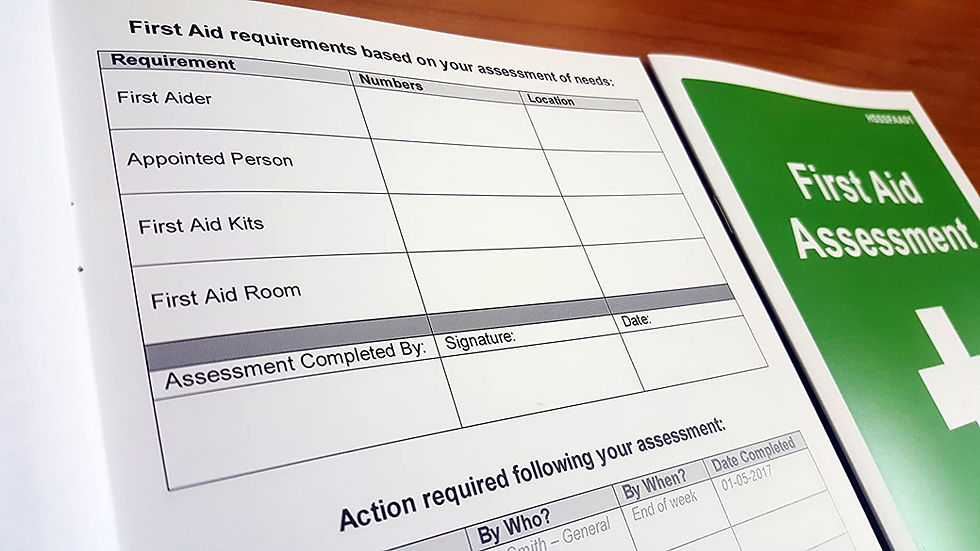Health and Safety Enforcements: what they are looking for?
- Train Direct

- Mar 1, 2023
- 3 min read
If you’re found to be in material breach of Health & Safety law, you will have to pay for the time it takes the inspector to identify the breach and subsequently advise what you need to do to put things right. This includes investigating the issues themselves and taking any enforcement actions.

There are several key areas we’ve discovered are becoming more popular for the HSE to focus on. So, in addition to making sure your risk assessments are in place and up to date, here are some of the most common areas inspectors lie to look for:
Hazardous substances
Have appropriate COSHH assessments been completed for substances in use in your business?
If you’re welding, do you know the makeup of the fume and required control measures?
If welding is undertaken, can the fume be controlled at source via the use of on-tool extraction? Is Local Exhaust Ventilation a suitable alternative?
If you use metalworking fluids, have you assessed the risks to workers of long term exposure and inhalation? Do you have bacterial testing measures in place with records kept?
Has appropriate training, instruction and supervision been given to employees about hazardous substances within the workplace (consider cutting fluid, wood dust and welding fume) themselves? Have you communicated the risk / CoSHH assessment findings?
Has air/exposure monitoring been undertaken and recorded to ascertain suitable controls are in place?
Is Respiratory Protective Equipment required, if so what type?
Is a minimum assigned protection factor required?
Has face-fit testing been completed? (using a Fit2Fit accredited tester)
Noise and vibration
Have noise risk assessments been undertaken for the workplace and hearing protection zones / control measures implemented?
Have Hand Arm Vibration (HAV) and Whole Body Vibration (WBV) assessments been undertaken for the workplace and control measures implemented?
Is health surveillance in place where required for: Hazardous Substances, Noise and Vibration?

Machine maintenance and guarding
Has the task been risk assessed and a safe system of work developed?
Are all respective guards or interlocks in place? Have you inspected these prior to use?
Has the operational manual been reviewed to consider requirements for maintenance?
Have the operators and engineers been appropriately trained in process and maintenance requirements?
Is there a lock-out, tag-out procedure in place?
Prior to starting the work has the machinery been purged of any stored energy or
hazardous substances?
Did you know? As of April 2022 the cost of recovery rate for the Fee For Intervention is £163.00
Working at height
Is a suitable and sufficient Risk Assessment in place?
Has it been completed by a competent person with involvement of the employees undertaking the work?
Has it been communicated to relevant parties? (i.e. those completing the work and those who may be affected by hazards arising from the work.)
Is the work at height planned, organised and carried out by competent persons?
Are ladders being used? Are they the correct type? Have they been inspected before the task is carried out?
Has adverse weather been considered if working outside?
Is access equipment being used? If so, what is the maintenance schedule? Is it the right equipment? Has it had its LOLER examination?
Is a work-restraint system in place? Is it suitable to prevent employees from accessing the edge/an area where they could fall?
Workplace transport
Has an appropriate risk assessment been completed that considers transport?
Has this considered blind spots? Bends? Pedestrian interactions? Gradients?
Is the site large enough for activities required? Loading/unloading, reversing etc.
Are vehicle routes wide enough for the types of vehicle needed?
Do drivers have required training and licensing to drive the vehicle?
Has a one way or traffic management system been implemented? What are the pedestrian segregation controls?
DSEAR (Dangerous Substances and Explosive Atmospheres Regulations)
Has a DSEAR assessment been undertaken if required?
Can the dangerous substances identified be substituted for a less hazardous alternative, the quantity reduced, or the work process changed to reduce the risk?
Are measures in place to reduce employees exposed to effects of dangerous substance?
Do drivers have required training and licensing to drive the vehicle?
Is an appropriate evacuation and emergency procedure in place?
How can we help?
We get that regulations can be hard to get your head around, knowing the different legislation or just staying on top of changes, there’s lots to get to grips with – we are here to help to the load off you. We’ll equip you with all the knowledge you need to be able to produce your own documentation and support you with managing the process as your business changes and grows.
Our Health & Safety experts can visit your business, identify any gaps in your current processes, and advise on any recommendations.
If you would like tailored advice for your workplace, book training for your business or organisation, or simply have a chat then get in touch with us today.
tel. 0330 223 5586,
email. info@traindirect.co.uk
form. complete the form on our homepage to request a call back.






Comments